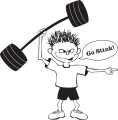Take this Nor’easter and Shovel It!

Originally published in South Coast Today.
Two weeks ago, I was on vacation basking in the sunshine of Key West with my warm weather clothes and sunscreen. While enjoying the beautiful tropical climate, I willfully deceived myself into thinking that our local inclement weather was tapering off.
No sooner did I promise my fellow northerners that I’d bring back some sunshine when we got slammed with a hefty nor’easter.
I’ve spent a good chunk of my adult life in weight rooms, and I lead an active lifestyle, but like so many others, I hate shoveling snow. As a strength-and-conditioning coach — and a frugal one at that — I can’t bring myself to buy a snow blower. People spend good money for the privilege of lifting heavy things and moving stuff around, so why not take advantage of Mother Nature’s offerings? On the other hand, you don’t have falling snow from tree branches going down the back of your jacket when you’re lifting weights.
The difference between mundane grunt work and recreational exercise is interesting. Physically they can be similar, but conceptually they are quite different.
A gym is a controlled environment, which offers all the right preferences for thoughtful and appropriate physical exertion compared to that of the great outdoors. You have a lot more control over choosing specific poundage to move; the world is your oyster for warm-up sets; and you can take sensible jumps in weight. When a workout calls for 20 pull-ups, you might do one set of 20, or two sets of 10, four sets of five, or any other split that gets you to 20. The training volume is the same when everything is said and done, but your body reacts differently to the various work bouts.
Shoveling out a driveway can also be divided in several ways as an overall physical undertaking. You can go slow and steady, you can go for broke, you can do it all in one fell swoop, or you can do it in multiple stages. It’s a lot more challenging to warm up in 20-degree weather, and while you have some control over the volume of snow per shovel load, you don’t have the luxury of starting with light fluffy snow then moving toward the medium denser stuff and then to the miserable wet heavy stuff. And, even though there are some measures that can be taken to more adequately ready our bodies, most of us cut corners and try to get it over with as soon as possible.
When this latest snowstorm hammered the SouthCoast region, I braced myself for the inevitable and then proceeded to break most of the exercise rules that I’m all too familiar with. And just for that extra feel of hypocrisy, my unwise methods and practices were the kind of things that I’m constantly yelling at my clients for doing.
In my past life as a competitive weightlifter, my training was all about preparing for six attempts that were extremely short in duration. It is this misguided mentality that gets me into trouble when it comes to shoveling snow.
Old habits die hard, and I tend to come out of the gate overly aggressively rather than budget my energy. Instead of lightly depositing my shovelful of snow on a nearby pile, I fling it for distance. I work extra hard, precariously balancing large snow boulders on the slippery face of my plastic shovel. And just to make a bad situation worse, I rush toward the finish line, acting like a sprinter at a marathon. It’s the exact opposite of the adage: work smarter, not harder.https://150a746088b13f0582945b364b05f910.safeframe.googlesyndication.com/safeframe/1-0-37/html/container.html
On the other hand, I’m pretty sound when it comes to the biomechanics of shoveling snow. The weight room has taught me well, whether it’s pulling barbells, moving furniture or shoveling snow. It may all look the same but there are many nuanced differences between varying techniques and styles. An overhand grip with your bottom shoveling hand is a little like a canoe paddle stroke, which brings in the posterior muscles of the shoulder and upper back, etc., whereas the underhand scoop motion is more bicep-oriented.
Many athletes work hard at perfecting their technique of a repetitive motion action, which suggests that shovelers should duplicate the exact same movement pattern and maintain a steady rhythm throughout the mission. In the weight room, however, we often strive for muscular balance and vary movements for this reason.
In the spirit of symmetry, injury prevention, and allowing for muscle recovery, I try to mix it up as much as possible when I shovel. I switch grips as I go, and I throw to both my left and right sides. I would change the old chestnut “lift with your legs, not your back” to lift with your legs and your back. Capitalizing on the large, strong muscles of your legs and back, and using them in concert with your upper body is efficient.
A couple of winters ago, I was nursing a hip injury so I was forced to cheat and shovel with all arms. Under these circumstances, it served me well as a protective measure, though it did not make for a great snow removal session. But there is not a definitive, right or wrong way.
One thing that is painfully clear is that I’d be doing a lot better for myself if I treated shoveling snow the same way that I approach exercise. I could have eaten a little bit better and hydrated before I went outside, I could have dressed more appropriately, I could have stretched inside my house prior to the undertaking, and I could have eased my way in by starting with some smaller volumes.
This was a cautionary tale. Don’t be like me! We should treat our bodies the right way whether it’s a road race or a load of laundry, a leisure-time workout or some homeowner drudgery.

Norm Meltzer aka The Muscle-less Wonder
